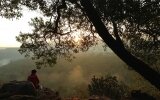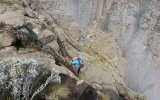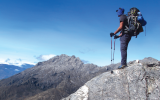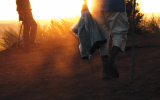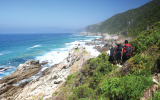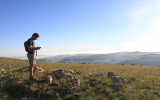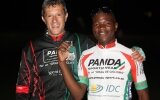- Magazine
- #readityourway
- Weekly Stories
- #shareyourstory
-
Adventure
- Abroad Travelling
- Africa Travelling
- Events
- Expos & Shows
- Festivals
- Fishing
- Free Diving
- Gliding
- Horse Riding
- Inspiring People
- Islands Travelling
- Kite/Windsurfing
- Motorbiking
- Motorised Water Sports
- Mountaineering
- Mountain Biking
- Off-road 4x4
- Off-road Motorbiking
- Paddling
- Performance Driving
- Photography
- Rock Climbing
- Rollerblading
- Sailing
- Scuba Diving
- Skateboarding
- Skydiving
- Snowboarding & Skiing
- Surfing
- Swimming
- Trail Running
- Wakeboarding
- Waveski Surfing
-
Sport
- Adventure Racing
- Fishing
- Free Diving
- Gliding
- Health & Fitness
- Horse Riding
- Inspiring People
- Kite/Windsurfing
- MMA
- Motorbiking
- Mountain Biking
- Multi-sport
- Off-road 4x4
- Off-road Motorbiking
- Paddling
- Performance Driving
- Photography
- Road Cycling
- Road Running
- Rock Climbing
- Rollerblading
- Sailing
- Scuba Diving
- Skateboarding
- Skydiving
- Snowboarding & Skiing
- Surfing
- Swimming
- Rugby
- Trail Running
- Triathlon
- Wakeboarding
- Waveski Surfing
- Lifestyle
- Calendar
A Pilgrim’s Progress
Matthew Holt | Photos: Matthew Holt & Fiona McIntosh
Topic:
Hiking
It was stinking hot, my hips grated and I was running with the grace of a pantomime horse. Fiona, meanwhile, had been bitten by a bedbug the previous night and her face had swollen up like a pumpkin. Just looking at her added to my woes. Ahead of us, two pilgrims materialised in the dust, barely moving. The man tottered on matchstick legs, like a drunk on stilts, and both calves were wrapped in filthy bandages. The woman had abandoned her hiking boots for sandals, with each toe individually dressed. As we shuffled past they cheerily shouted, "Buen camino peregrinos." It was then that I knew we’d reach Santiago, even if we still had over 400 km to go.
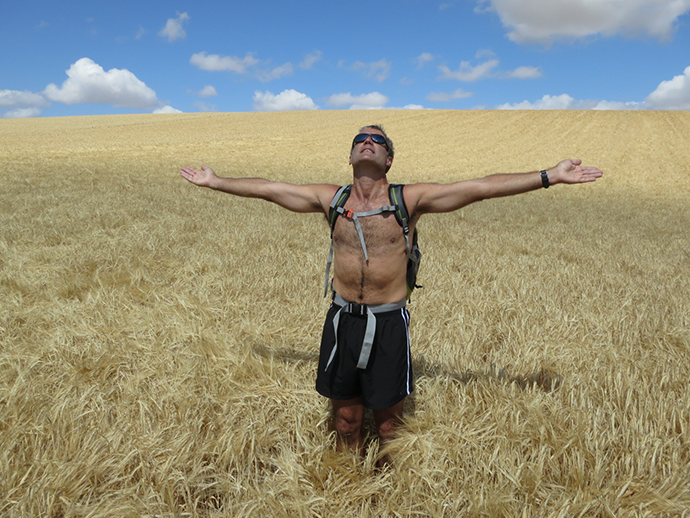
The Camino de Santiago, or Way of St. James, has drawn pilgrims to Santiago de Compostela in northwest Spain for more than twelve centuries, even if the historical basis for the trip is actually quite flimsy. Supposedly, after Christ’s death, the Apostle James travelled to Spain to spread the word, but quickly gave up and returned to Jerusalem, where he was executed by King Herod. His followers took his body back to Spain and buried it at Santiago.
When a shepherd discovered a tomb in 813, the local bishop declared it belonged to St. James, whose ghost then helped the Spanish drive out the Moors and restore Christian rule. Whatever the merits of this tale, pilgrims were soon beating a path to visit St. James’ remains in the Santiago Cathedral, encouraged by the Catholic Church offering ‘indulgences’ (or pardons) to those making the journey. By the twelth century, Santiago was attracting half-a-million pilgrims each year and there was even a guide book. Thereafter, successive wars reduced the flow of pilgrims to a trickle, but in the last decade it’s taken off again, with more than 100,000 arriving annually in Santiago to claim their official compostela and indulgence.
The train from Bayonne was full of pilgrims of all nationalities, shapes and sizes. Then again, in medieval times my fellow travellers would have included murderers and thieves, plus professional pilgrims hired by affluent sinners to collect their indulgences for them. No one alighted till the final stop, St-Jean-Pied-de-Port, an ancient walled village at the foot of the Pyrenees. There’s no starting line for the Camino, whereas in medieval times a pilgrimage commenced at your front door. with modern transport it’s a bit more complicated and you have to decide where to start. Officially, to qualify for a compostela you must travel at least 100 km on foot (or 200km by bicycle). However, for credibility amongst fellow pilgrims, you should start outside Spain, with St. Jean being the most popular departure point. From there, it’s 790 km to Santiago. As soon as the train stopped, we sprinted up through town to the pilgrim office to register for our credencial or pilgrim passport, necessary to obtain a compostela in Santiago and cheap accommodation along the way.
The next morning we were woken early by bright sunshine and the sound of hiking boots and poles on the cobbled streets outside. Having spent the night sampling local cider, it was a bit later when we passed under the Porte Notre Dame, which led out of town. Like most pilgrims, we were planning to make Spain that day, some 25 km away and a 1,300 m climb over the Pyrenees via the ‘Route de Napoleon’, the way used by the French troops to invade in 1808 and also retreat five years later. A stiff climb led out of the valley to Pic D’Orisson, marked by a shrine to the Virgin Mary plus memorials to pilgrims whose journeys ended prematurely. On such a glorious day it was difficult to perceive any menace. Five years earlier, however, a colleague of mine had died of hypothermia as a result of being caught out in a freak snow storm. We paused on the cliff edge, watching vultures wheel on the thermals, before starting the steep descent into Spain.
On our second day, we reached Pamplona. With the Festival of San Fermin about to start, the city was in party mood, the squares packed, the bars buzzing and the barricades up for the bull run. We reluctantly pushed on, into the wheat fields of Navarre and vineyards of Rioja. Typically, we covered about 45 km each day, though it’s fair to say we weren’t clocking Olympic medal times. Early mornings were best, when the day was still fresh, the scents sharp and the air full of birdsong. By noon, however, the sun would be blazing, the heat oppressive and landscape bleached. Then, the sensible pilgrims would leave the trail and our only company would be cyclists freewheeling past and a few other long-distance addicts.
Over the centuries, infrastructure has grown along the route, with restaurants and hostels dedicated to pilgrims. The restaurants all offered ‘pilgrim menus’, which were pretty much the same, bar one stand-out dish - like paella or fillet steak - that tempted you in and was never available. On the plus side, each meal came with copious amounts of red wine so we could drink away our aching legs. Meanwhile the hostels varied greatly. Some were impersonal like reformatories, others offered private rooms; some were spartan but clean, others infested with bedbugs.
We crossed the Montes de Oca in a ghostly mist, passing a stark memorial to Civil War victims. If St. James had assisted the Spanish against the Moors and Napoleon, he failed to protect them from each other, with the vicious conflict between 1936 and 1939 claiming half-a-million lives. Then came a long slog into Burgos, with its impressive architecture and, more importantly, piazzas lined with tapas bars. After seven days and 300 km, we felt we deserved spoiling. The city was also long on monuments to its favourite son, the eleventh century warlord ‘El Cid’. Dying under siege in Valencia, he was reinterred in Burgos with his favourite horse, and then dug up and reinterred again alongside his wife. It’s not clear which he preferred.
After Burgos, came the meseta, a high farmland plateau with endless wheat fields, few trees and little shelter from the relentless sun. Sometimes the route followed 2,000-year-old Roman roads, cutting through fields as straight as plumb lines. While we admired the Romans’ discipline, we did question their imagination: just a few blind corners or bends would have cheered us no end. Our days on the meseta blurred into one long, panning shot of dazzling cornfields and a straight, white gravel path disappearing over the horizon.
The villages on the meseta existed in a time warp. There was no indication that Spain had just become European football champions or gone bankrupt, with riots breaking out in Madrid. No, the locals carried on as they’d always done, siesta-ing through the day and gathering at dusk in the plaza for an alfresco vino. With virtually no one speaking any English, we had to rely on pidgin Spanish and sign language.
Eventually, we reached the city of Leon, with its Gothic and Renaissance architecture and palace designed by Gaudi. After four days on the meseta we didn’t really care, heading straight to a restaurant for lunch. In fact, the worst section of the Camino came next, on the road out of Leon. The villages had physically died, with all the shops boarded up, the houses deserted and every property for sale. There were no people; even the ghosts had gone. Having planned to stay at a hostel that existed in our guidebook but not in reality, we had to run an extra 10 km and bunk down in a school hall, along with 50 other people who had the same book.
A few pilgrims were on similar schedules to ours and for several days shared our dormitories and restaurants. There was the felt-hatted German, who was witty in the morning, weird in the afternoon and rabid drunk each evening; the rugged Austrian ski instructor, who hoped the Camino would reveal which of his two pregnant girlfriends to settle down with; and the earnest Canadian, who awoke one morning with the revelation that man was made for walking. His wife barred him starting from home, so he’d negotiated a vacation to do the Camino. He was last seen boarding a bus outside Leon, with a sore leg. They were important characters for a few scenes in our play, before drifting off and becoming part of someone else’s Camino.
I always feared the hardest part would come after we’d passed the halfway point, but were still too far out to pretend we were on the home straight. It was no compensation being proved right. On our thirteenth day, while running up Santo Toribio, my left shin exploded in pain and I instinctively thought I’d been shot. Fiona more mundanely diagnosed shin splints. With 260 km to Santiago, I doubted I could walk there, let alone run. Along the Camino are several sites where St. James allegedly appeared to pilgrims in their hour of need, spouting a cool spring or performing a resurrection. You can take these reputed miracles as you like. Anyhow, sitting there morosely mulling our predicament, we spotted a scarecrow that someone had kitted up as a pilgrim, with a rucksack and trekking pole. After a few furtive glances, I purloined the latter, thus enabling me to hobble to Astorga, where I raided pharmacies for strapping and anti-inflammatories.
The next few days were tough, crossing two mountain ranges and the Camino’s highest point, the 1,515 m Punto Alto. But they were also the most rewarding. In hindsight, till then we’d had it too easy, running along in a capsule, confident we’d make it, oblivious to everyone else. It was only after my leg went lame that I had to deal with obstacles and uncertainty. That was when I realised the Camino is not a race and I couldn’t do it on my own, and when I reflected that it might be a metaphor for my life, but perhaps by then I’d had too much red wine.
Once we reached Sarria, we had 110 km to go and knew we’d make it. Sarria is the traditional starting point for ‘express pilgrims’, with limited time or in urgent need of a pardon, plus large school and scout parties. The newcomers were conspicuous by their small packs, clean clothes, un-bandaged legs and even gait. Worse still, rather than suffering, they were clearly having fun, laughing, singing and playing dead ants. It was hard not to feel superior.
By the last 50 km, the Camino had lost any charm, with too many people for the infrastructure. The pilgrims had merged into one long noisy Chinese dragon, most way-markers were defaced (embarrassingly in English) and the route was lined with soiled toilet paper. The spirit had also changed, with the congestion producing outbursts of temper. Coming out of Palais de Rei, a cyclist tore past, shouting abuse and running over my foot. I snarled back after him. Of course, I should have turned the other cheek and wished him buen camino, but it will take more than a pilgrimage to make me such a person.
On our twentieth day, we descended from Monte do Gozo, drawn on by the sight of Santiago’s spires, now only 3 km away and better still, downhill. Finally we were in the grand square, craning our necks before the towering cathedral. There was no finishing line or ticker tape, just crowds of milling tourists and street vendors. Getting there was always likely to be an anti-climax, but maybe a pilgrimage is less about the destination and more about the journey. As it was, for medieval pilgrims reaching Santiago was only halfway. They had to turn round and retrace their steps, facing the same distance and hazards. Fortunately times have changed. After collecting our compostella and attending pilgrim mass, we caught a flight home.
dinFO
1. There are numerous starting points along the Camino, though you must hike at least 100 km to receive your compostella in Santiago. The most popular long-distance route is the 790km Camino Frances from St-Jean-Pied-de-Port.
2. Most pilgrims take 30 to 35 days to complete the Camino Frances.
3. Ryanair flies from London Stansted to Biarritz (where you catch a bus to Bayonne and then a train to St-Jean) and back from Santiago to London Stansted.
4. The most useful guidebook is A Pilgrim’s Guide to the Camino de Santiago by John Brierley.
Issue:
Issue 23 Mar '13
Contributor:
Matthew Holt

